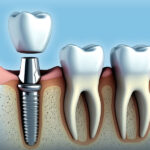Bridging gaps between two missing teeth is not always an easy task unless you discuss the options with your dentist and arrive at a decision after careful thought. Replacing the missing tooth will be the first concern in the mind of the dentist who may offer you dental implants. However, if you are not prepared for the procedure or searching for an alternative you may also be offered dental bridges that can literally bridge the gap left behind by the missing tooth.
A dental bridge comprises of two or more crowns for the teeth on both sides of the Gap and the to crowns are called abutments. A false tooth or teeth are placed between them. The false teeth made from either gold, porcelain, alloys, or various materials combined are called Pontics. Dental bridges receive support from natural teeth or implants.
The Benefits of Dental Bridges
A bridge in the mouth is beneficial in many ways because it can:
- Restore your smile and your ability to speak and chew properly.
- Distribute your biting forces properly by replacing missing teeth.
- Sustain the pattern of your face and stop the surviving teeth from shifting out of position.
What Kind of Dental Bridges Are Available?
Three main types of dental bridges are presently available. They are:
Traditional bridges are the most common and are made from porcelain fused to metal or ceramics. They involve creating a crown for the tooth or implant on both sides of the missing tooth with a pontic in between.
Cantilever bridges can be used when there are neighboring teeth on one side of the missing tooth. These are not common any longer and are not recommended in the posterior region of the mouth where they can put too much force on the other teeth and damage them.
Maryland bridges can be made from porcelain, porcelain fused to metal or false teeth and gums supported by a porcelain or metal framework. Metal or porcelain wings on one side of the bridge are bonded to your existing teeth.
The Process for Getting Dental Bridges
The dentist you visit for dental bridges will prepare the abutment teeth during the first appointment. The preparation requires the dentist to remove some enamel from your tooth to make room for crowns to be placed on them. After preparing your teeth impressions will be made to serve as a model from which the pontic, bridge, or crowns will be made by the dental laboratory. Your dentist will place a temporary dental bridge over the exposed teeth and gums for protection as the permanent bridge is being made by the laboratory.
During your second visit, the dentist will remove the temporary bridge and the newly developed porcelain or metal bridge will be checked and adjusted as needed to achieve proper fitting. You may require to visit your dentist multiple times to check the fitting of a metal framework and bite. If the dental bridge is a fixed bridge the dentist may temporarily bond it in place for a couple of weeks to determine if it is fitting properly and thereafter cement it in place permanently.
What Is the Lifespan of Dental Bridges?
Dental bridges can be expected to last 5 to 15 years or even longer. If you are indulging in good oral hygiene habits and visit your dentist regularly for checkups dental bridges can last for over a decade. Caring for dental bridges is essential because they are just a strong at the foundation for by the surrounding teeth. You will be required to brush two times a day for two minutes each and floss at least once and also use an antiseptic mouthwash every day to inhibit tooth decay and gum disease. If you do not take proper care of your mouth you will not be able to retain your fixed bridge teeth and may require dental bridge replacement in Cambridge.
Keeping a regular cleaning schedule with your dentist at Dental Art Clinic will also help to identify any problems at an early stage when treatments can offer a better result. Having a balanced diet for proper nutrition will also be recommended by the dentist. The dental bridge is a method to close the gaps left by the missing teeth in your mouth but the bridges are also susceptible to decay leading to a significant investment being required for new dental bridges. Therefore it is suggested that you care for the dental bridges from the onset to ensure your investment is safeguarded properly.






